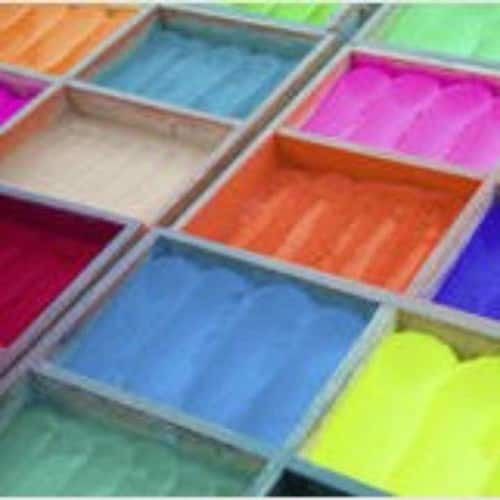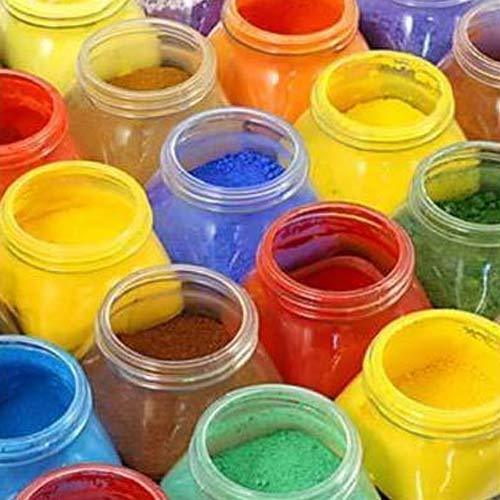Thermochromic Dyes
MOQ : 1 Kilograms
Thermochromic Dyes Specification
- Resistance
- Light / Heat / Solvent Resistance (moderate)
- Poisonous
- Non-toxic
- Grade
- Industrial Grade
- Purity
- 99%
- Structural Formula
- Proprietary
- HS Code
- 32041999
- Density
- 1.2 Gram per cubic centimeter(g/cm3)
- Smell
- No distinct odor
- Appearance
- Fine Powder / Dispersion
- Molecular Formula
- Proprietary Blend
- Molecular Weight
- Proprietary
- Other Names
- Temperature Sensitive Dye
- Melting Point
- 85-120C (varies by Dyes)
- Taste
- Odorless
- Shape
- Granular / Microencapsulated
- Physical Form
- Powder / Liquid
- Solubility
- Dispersible in water/oil depending on type
- Ph Level
- 5.5 7.5
Thermochromic Dyes Trade Information
- Minimum Order Quantity
- 1 Kilograms
- Supply Ability
- 50000 Kilograms Per Week
- Delivery Time
- 3-7 Days
About Thermochromic Dyes
Thermochromic dyes are a type of color-changing pigment that responds to changes in temperature by altering their color. These dyes are often used in various applications ranging from novelty items to industrial sensors. They work on the principle of reversible molecular rearrangement, where the molecules change their structure in response to temperature variations, leading to alterations in the absorption and reflection of light, thus changing the perceived color.
There are two main types of thermochromic dyes:
1. Reversible Thermochromic Dyes: These dyes change color when subjected to temperature changes but revert to their original color when the temperature returns to its initial level. This reversible property makes them suitable for applications where repetitive color changes are desired.
2. Irreversible Thermochromic Dyes: Unlike reversible dyes, irreversible thermochromic dyes undergo a permanent color change upon exposure to certain temperatures. Once activated, they do not return to their original color, which can be useful in applications such as indicating when a certain temperature threshold has been reached.
Thermochromic dyes find applications in various fields, including:
1. Packaging: They are used in packaging materials to indicate temperature variations during storage or shipping. For example, they can signal if a product has been exposed to high temperatures that may compromise its quality or safety.
2. Textiles: Thermochromic dyes are employed in textiles to create interactive fabrics that change color with temperature fluctuations. These fabrics have applications in fashion, sportswear, and even medical textiles where they can indicate changes in body temperature.
3. Toys and Novelties: Thermochromic dyes are popular in toys and novelties, such as color-changing mugs, mood rings, and stickers, adding an element of fun and interactivity.
4. Industrial Applications: They are utilized in industrial processes as sensors to indicate temperature changes in machinery or during manufacturing processes.
5. Security Printing: Thermochromic inks are used in security printing applications such as banknotes, passports, and tickets to provide a visual indicator of authenticity. These inks can reveal hidden patterns or messages when exposed to specific temperatures.
Versatile Application Spectrum
Thermochromic dyes are valued for their broad utility across sectors such as textile printing, plastics, coatings, inks, and toys. Their adaptability to various printing techniquesscreen, offset, flexo, and gravureenhances design possibilities and functional uses including temperature indicators and security features. They can also be mixed directly with raw polymer, expanding their integration into industrial processes.
Product Stability and Storage
To maximize shelf life and performance, store thermochromic dyes in a cool, dry environment away from direct sunlight. If maintained under recommended conditions, these dyes remain stable for up to 12 months. Their non-toxic composition and moderate resistance to light, heat, and solvents ensure safe and reliable usage in a variety of manufacturing and finishing operations.
FAQs of Thermochromic Dyes:
Q: How do thermochromic dyes change color with temperature?
A: Thermochromic dyes undergo a visible color transition within the 0C to 70C range, depending on their specific grade. This immediate color change is triggered by the ambient temperature, making them suitable for dynamic designs and temperature indicators.Q: What are the main applications of thermochromic dyes?
A: These dyes are widely used in textiles, inks, plastics, coatings, toys, temperature indicators, and security printing. Their compatibility with various systems allows for versatile integration into both industrial and consumer-oriented products.Q: Where should thermochromic dyes be stored to maintain their shelf life?
A: To optimize longevity, thermochromic dyes should be kept in a cool, dry place away from direct sunlight. Proper storage can extend the shelf life up to 12 months and help preserve their performance characteristics.Q: What colors are available for thermochromic dyes?
A: Multiple color options are offered including red, green, blue, orange, pink, purple, yellow, and more, allowing users to tailor their choice for specific visual effects and functional applications.Q: How can I apply thermochromic dyes in my manufacturing process?
A: Thermochromic dyes can be applied using screen, offset, flexo, or gravure printing techniques or mixed directly with raw polymer. Selection of method depends on the intended application and system compatibilityaqueous or non-aqueous.Q: What are the benefits of using microencapsulated thermochromic dyes?
A: Microencapsulation ensures a particle size of 310 m, providing controlled and efficient color change, enhancing dye stability and protection, and facilitating smooth blending in various matrices without compromising product quality.
Tell us about your requirement

Price:
Quantity
Select Unit
- 50
- 100
- 200
- 250
- 500
- 1000+
Additional detail
Mobile number
Email
More Products in Fine Chemical Category
Synthetic Organic Dyes
Price 80 INR
Minimum Order Quantity : 1 , , Kilograms
Poisonous : Other, Yes (handle with care and PPE)
Purity : 9699%
HS Code : 3204
Taste : Other , Tasteless
Copper Phthalocyanine Pigment
Price 60 INR
Minimum Order Quantity : 1 Kilograms
Poisonous : Other, Nontoxic
Purity : 99%
HS Code : 32041700
Taste : Other , Odourless and Tasteless
Polyester Dyes
Price 75 INR
Minimum Order Quantity : 1 , , Kilograms
Poisonous : Other, NonPoisonous
Purity : 99%
HS Code : 3204
Taste : Odorless
Clothing Dye
Price 60 INR
Minimum Order Quantity : 1 , , Kilograms
Poisonous : Other, No
Purity : 99% Min.
HS Code : 3204
Taste : Odorless
"We only deal in Foreign Markets"
 |
MEGHA INTERNATIONAL
All Rights Reserved.(Terms of Use) Developed and Managed by Infocom Network Private Limited. |
 English
English Spanish
Spanish French
French German
German Italian
Italian Chinese (Simplified)
Chinese (Simplified) Japanese
Japanese Korean
Korean Arabic
Arabic Portuguese
Portuguese
 Send Inquiry
Send Inquiry




